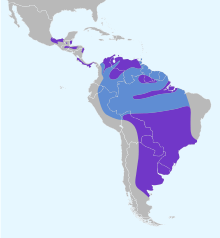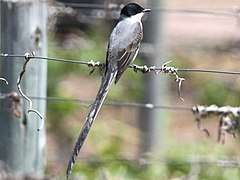Fork-tailed flycatcher
The fork-tailed flycatcher (Tyrannus savana) is a passerine bird of the tyrant flycatcher family, and is the member of a genus typically referred to as kingbirds.
| Fork-tailed flycatcher | |
|---|---|
_female.jpg) | |
| T. s. monachus in panama | |
| Scientific classification | |
| Kingdom: | Animalia |
| Phylum: | Chordata |
| Class: | Aves |
| Order: | Passeriformes |
| Family: | Tyrannidae |
| Genus: | Tyrannus |
| Species: | T. savana |
| Binomial name | |
| Tyrannus savana Vieillot, 1808 | |
 | |
Description and ecology
This bird occurs in a wide variety of habitats including pastures, riparian forests, and open residential areas with scattered trees. Its breeding range is from central Mexico to central Argentina. In most of this range it is usually found year-round, but in the southern parts of its range it retreats northward for the winter. This species is also known to wander widely. It occurs almost annually in the eastern United States seaboard and Canada.
This flycatcher builds a shallow cup nest 1–10 m (3.3–32.8 ft) high in a shrub or short tree. Females normally lay two or three eggs.
The fork-tailed flycatcher is white below, gray above, and has a black cap. Males sometimes show a yellow crown stripe. Males also have an extremely long forked tail, of even greater length than that of their cousin, the scissor-tailed flycatcher. Females have a somewhat shorter tail, while it is significantly shorter in juveniles. Males are 37–41 cm (15–16 in) in length; females, 28–30 cm (11–12 in), including tail. They weigh only 28–32 g (0.99–1.13 oz), much less than closely related kingbirds, which are half the total length of this species. The tail in adult males is 2–3 times longer than the length of the bird from the bill to the base of the tail.
This species is primarily an insectivore, but will switch to berries and small fruits during winter if insects become scarce.
References
- BirdLife International (2012). "Tyrannus savana". IUCN Red List of Threatened Species. 2012. Retrieved 26 November 2013.CS1 maint: ref=harv (link)
External links
| Wikimedia Commons has media related to Tyrannus savana. |
| Wikispecies has information related to Tyrannus savana |
- "Fork-tailed flycatcher media". Internet Bird Collection.
- Fork-tailed flycatcher Stamps from Argentina, Brazil, Falkland Islands, Grenada, Trinidad and Tobago, and Uruguay at bird-stamps.org
- Fork-tailed flycatcher photo gallery at VIREO (Drexel University)
- Fork-tailed flycatcher Photo at John Kormendy's Birds of Brazil website
- BirdLife species factsheet for Tyrannus savana
- Fork-tailed flycatcher species account at Neotropical Birds (Cornell Lab of Ornithology)
- Interactive range map of Tyrannus savana at IUCN Red List maps
- Audio recordings of Fork-tailed flycatcher on Xeno-canto.
- Citizen science observations for Fork-tailed flycatcher at iNaturalist

